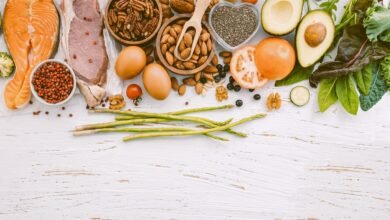What Are the Healthiest Types of Bread?

Bread doesn’t exactly have a reputation for being slimming—or, for that matter, healthy in general. Considering the popularity of low-carb and gluten-free diets, you may find it difficult to think of bread in a positive light for health.
But despite criticism that it’s fattening or too high in carbs, the right kind of bread can actually be an extremely healthful food. After all, many breads have a simple ingredient list that begins with whole grains—and eating more whole grains is associated with lower weight and reduced risk of heart disease, cancer, and death by any cause.
Keeping bread in a healthy diet comes down to choosing varieties with the best nutrition (because all breads are definitely not created equal).
To set the record straight on which are healthiest, we’ve evaluated various types based on amounts of fiber, protein, micronutrients, and total calories, as well as what research says about their health benefits.
100% Whole Wheat Bread
It’s no surprise that 100% whole wheat bread packs an abundance of fiber and nutrients–and is one of our picks for the healthiest variety.
An average slice of bread made with all whole wheat flour provides 80 calories, 5 g protein, 0 g fat, 20 g carbohydrates, and 3 g fiber.
One hundred percent whole wheat breads also contain varying amounts of essential minerals like selenium, manganese, calcium, thiamin, and phosphorus.
Meeting your nutrient needs is all well and good, but the end goal of good nutrition is, of course, actual health outcomes. Whole wheat bread certainly delivers in this department.
Increasing whole grains (like those in 100% whole wheat bread) has been shown to reduce the risk of multiple chronic diseases, including type 2 diabetes, cancer, and heart disease.
Plus, several studies have demonstrated the positive effects of whole grains on weight control. A 2018 study found that when adults replaced refined wheat with whole wheat in their diets, they experienced a significant loss of visceral fat.
Pay Attention to Labels
Just keep in mind that many breads that advertise themselves as whole wheat might not contain 100% whole, unrefined grains.
Practice diligent label reading to determine whether a store-bought bread was made only with whole wheat flour. A 100% whole wheat bread will either be labeled as such, or will have whole wheat flour as its first ingredient (and won’t list other flours like “wheat flour” or “enriched bleached flour”).
Multigrain Bread
Wheat isn’t the only grain that deserves its fair share of glory for health benefits. Other whole grains like oats, amaranth, buckwheat, barley, and millet can find their way into multigrain breads for added fiber, protein, and micronutrients.
Again, adding a variety of whole grains such as these is an evidence-based way to reduce the risk of multiple chronic diseases.
That said, navigating your way to a healthy multigrain bread can be somewhat tricky. When breads are labeled as multigrain, it can be difficult to tell whether the grains that went into them were actually whole, or have been refined. Look for a multigrain bread labeled as “100% whole grain.”
Sprouted Grain Bread
Whole grains are healthy to begin with, but harvesting them at the point of germination—as in, when they sprout—drives their nutrient content even higher.
Sprouted grains contain higher amounts of vitamins and minerals like folate, iron, vitamin C, zinc, and magnesium, making them another healthy building block for bread.
In addition to upping the micronutrients in bread, sprouted grains has an effect on macronutrients, too. Sprouted grains are higher in protein, which means they may keep you fuller longer (potentially giving weight management a boost).
Meanwhile, if you’re trying to keep carbs to a minimum, sprouted grains can help. They tend to be lower in carbohydrates, since the germination process breaks down starch.
With their high protein and fiber, sprouted grain breads also have a relatively low glycemic index. (Food for Life’s Ezekiel 4:9 sprouted grain bread, for example, has a glycemic index of 36.) This means they won’t raise your blood sugar as quickly as some other breads, like white bread, which has a glycemic index of 75.
Consider sprouted grain breads as a nutrient-packed, healthy sandwich choice—or, for even more fiber, choose brands that combine sprouted grains with legumes like lentils, beans, or peas.
Oat Bread
Oats aren’t just for oatmeal! These whole grains can supplement whole wheat in healthy store-bought and homemade breads. Oats contain a special type of fiber called beta glucan, which boasts benefits like lowering bad cholesterol, steadying blood sugar, and bringing down blood pressure. They’re also especially high in soluble fiber, which can help reduce constipation.
It’s important to be label-savvy when choosing a healthy oat bread. Look for brands that list oats and whole wheat flour as the first ingredients and contain minimal added sugars.
Flax Seed Bread
Flaxseeds aren’t grains, but that doesn’t mean they aren’t packed with nutrients. These little seeds are high in fiber and healthy polyunsaturated fats. Adding flaxseed to your diet might help protect against some cancers, as well as improve heart health.
Plus, the seeds are naturally gluten-free, so breads made with them (instead of wheat) can be a good choice for those with celiac disease or gluten sensitivity.
Grinding flax seeds turns them into a meal that can serve as the basis of a tasty, healthy bread. Some commercially prepared breads use flax in combination with wheat, but for a loaf made entirely with flaxseed (and no wheat) you may have to make your own.
Fortunately, many flaxseed bread recipes are unyeasted, meaning they don’t require lengthy rising and proofing times.
Sourdough Bread
The iconic bread of San Francisco isn’t just delicious—it actually has hidden health benefits. Sourdough bread is made via a fermentation process that adds healthy probiotics to its finished product.
A diet rich in probiotics from fermented foods has been linked with all sorts of positive health outcomes, like improved digestion and better immune function. And since many experts believe it’s best to get probiotics from foods, rather than supplements, sourdough can add to your daily dose.
For the healthiest sourdough bread, choose a variety made with whole wheat flour. Not only will you soak up the bread’s natural probiotics, you’ll get extra fiber, protein, and minerals, too. You can also make your own sourdough bread at home. It’s easier than you might imagine and it allows you to control some of the ingredients.




